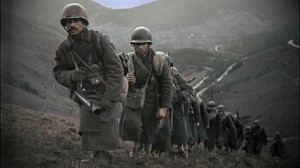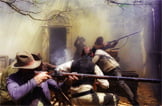With A+E Networks channel History using History Makers International to strengthen its drive into character-led reality, the debate about just what counts as a factual programme raged in New York. Clive Whittingham reports.
It took until the start of the second day, but the obvious audience question eventually came.

Apocalypse
With executives from A+E Networks-owned History queuing up to sing the praises of their new factual reality series Swamp People and Pawn Stars and state their aim of chasing younger audiences with returnable entertainment series, one had to wonder where all the traditional history programming had gone.
A session about the Apocalypse programmes on the two world wars and the Cold War felt more traditional. And the two-day conference was rounded off with a preview of three different series about the Titanic disaster, ahead of its 100th anniversary this year.
But at times you had to look hard for the history at History Makers this year, and that point was put to Mary Donahue, VP of development and programming at History, during Friday morning’s session on finding characters for your character-driven hits.
Donahue was swift to challenge the assertion that History is no longer a channel about history. She said: “I get asked that question a lot. If I look at Pawn Stars, there is a lot of history baked into that show.
“The fact that history is presented wrapped in entertainment doesn’t mean that the core information isn’t there. In every Pawn Stars episode you learn the history of the objects – the time in which the object was made, what it’s worth and why it’s worth that.
“So history is at the forefront there, in a really fantastic way, and the fact that it’s not boring doesn’t mean that it’s not history. History can be entertaining. Our tagline ‘History made everyday’ is where we live, and we also believe that information need not be dull.”
Donahue also pointed to the historical information about native Americans, the Louisiana landscape, Cajun communities and America’s deep south that are all included in Swamp People.
The day before, Dirk Hoogstra, senior VP of development and programming at History and its fledgling spin-off H2, raised eyebrows when he described his networks as “entertainment channels” and said they were pursuing character-driven hits to drive down the median age of their audience.
He said: “On History, we are constantly looking for character-driven. With H2, we have done quite well with programmes that are contributor-based and narrator-based.

Swamp People
“With H2 we don’t want to go back to what history was 10 years ago. We want information to be the star of the network, but we want to bring it back in an entertaining way. If you have that spectrum of entertainment and information, the channel is still somewhere in the middle, but it’s more to the content side of the spectrum.”
And all the execs were keen to point to big-budget, landmark series America: The Story of Us and Mankind: The Story of All of Us, from Jane Root’s Nutopia, as proof that money will still be committed to more traditional history series.
Carl Lindahl, executive producer of programming at History, told delegates at the Titanic session on Friday that 2011 had been a year of anniversaries, including the beginning of the American Civil War (1861) and the bombing of Pearl Harbour (1941), which had all been covered extensively by the channel.
Brent Montgomery, the owner and executive producer of Leftfield Pictures, which makes Pawn Stars and Monster In-Laws, among other factual reality series, said programme makers should embrace the new direction the genre is taking.
Montgomery said: “I always tell people who have done documentary stuff that the amazing thing about reality is that you take what would have been an incredible documentary, like Swamp People, and make it into 50, 60, 200, 300 episodes by really finding those great characters. That’s a great way to monetise a great idea.”
And that – money and ratings – is the point. People are queuing up to watch character-led programmes, which is why Discovery, A+E and others are chasing them.
Michael Katz, chairman of the conference advisory board for the last five years and VP of international programming and production at A+E, told C21 on Friday that there was still room for hard-hitting current affairs programming and traditional, perhaps drier, history programming, but that A+E is not really interested in housing it.
Katz said: “The trajectory that we’re on now is for series programming and hard-hitting current affairs programming is not something our channel brands would automatically embrace – but never say never.

America: The Story of Us
“There are so many different outlets now that could really showcase this kind of programming much more effectively than our channel brands. Right now we’re working to our strengths and we seem to be going from strength to strength with factual entertainment shows and series, and also large specials.”
Those different outlets include Al Jazeera and Al Jazeera English. Often written off in the US as a sort of ‘terrorist TV’ because people used to associate it with broadcasts of video messages from Osama Bin Laden, Al Jazeera is increasingly forging a reputation as the go-to channel for hard-hitting current affairs docs.
Diamuid Jeffreys, programme editor at Al Jazeera English’s People and Power strand, stunned the New York audience with clips from a series of quick-turnaround docs aired during the Arab Spring last year. Afterwards, he told C21 that broadcasters have a duty to bring these stories to the mass market.
He said: “There are so many important things happening in the world, so many extraordinary events happening every day. We have to document them, analyse them, break them down and make them explicable.
“Our coverage of the Arab Spring added hundreds of thousands of people who came looking because we were doing it. There’s a message there for other broadcasters: don’t abandon real stories about real people in real situations doing important things.
“If you’re making a series called Pets With Tourettes and that’s all that’s on TV, in the end people are going to get bored with it. You can dress it up as factual programming as much as you like but in the end it’s entertainment. Now there’s nothing wrong with entertainment, and it’s very important we have it, but sometimes it can’t address the important things in life and people need those questions asked.
“I understand why a channel aimed at teenagers is not going to cover events in another part of the world, because teenagers aren’t coming to that channel looking for that, but it still means you have a responsibility to put it somewhere and not bury it away in the early hours of the morning.”
There were more solemn faces and talk of responsibility during a session with producers from Japanese pubcaster NHK, although incredibly the channel’s executives said they feel guilt for not doing more to prevent deaths in the wake of last year’s devastating earthquake, tsunami and subsequent nuclear incident.
Shin Yasuda, producer, international coproduction at NHK, told delegates: “Over 15,000 people lost their lives and 3,000 people remain missing. This was a huge disaster and there is a lot of discussion among producers and journalists at NHK about a sense of remorse and helplessness and thinking we could have done better.
“Perhaps if we had provided another piece of information or different reportage we could have saved one more person or one more child from going under the water.”
The answer to all this may have been found tucked away on the seventh floor, during an afternoon session on Thursday.
Half the Sky is a multimedia television project based on the book of the same name and will air at the end of this year. The programme makers have covered every base to get across their messages about women’s rights around the world, using a television series accompanied by educational material, social media apps, websites and even games.
Whether a mobile phone game in which the player helps a young girl tackle her worms with tablets will ever be a goer is up for debate, but it seems such a well-rounded package is required these days to get your hard-hitting factual project off the ground.
That or characters to lead it.